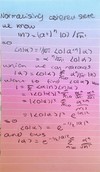Quantum optics Flashcards
(41 cards)
Photon wavefuncitons must be
symmetric because they are bosons
Why can ladder operators be used on E and B fields?
Because the oscillation between E and B energy is mathematically equivalent to the oscillation between potential and kinetic energy in a harmonic oscillator
[a, a+] =
1
Electric field operator
E_o (a + a+) sin kz
where E_o = (h_bar w /epsilon_o L)^1/2
Magnetic field operator
-i E_0/c (a - a+) cos kz
Hamiltonian of light field
h_bar w (a+a + 1/2)
Creation operator acting on a number state
a+ |n> = sqrt(n+1) |n+1>
Anihilation operator acting on a number state
a|n> = sqrt(n) |n-1>
Number operator is
a+a
Why are E and B fields of a number state not well defined?
Because they depend on (a + a+) which has a non-zero standard deviation
Variance of E and B fields
2n+1
Thermal state =
inchoherent mixture of number states

Coherent state =

Action of the annihilation operator on a coherent state
a|alpha> = alpha|alpha>
Show that coherent states are minimally uncertain

Mean photon number of coherent state
alpha^2
Find the normalisation of the coherent state

How does coherent state evolve with time?
Remains same coherent state but with accumulated phase
Variance of E and B fields of coherent state
1
How can a generic number state be expressed in terms of the vacuum state?

Action of a beam splitter

What is photon bunching/the Hong-Ou-Mandel effect?
When two photons with identical polarisation are incident on different inputs of a beamsplitter, both photons will exit through the same port.
What is the displacement operator?
exp(alpha a+ - alpha*a)
D|0> = |alpha>
It is a unitary operator
Can displacement operators be combined by adding arguments?
No






